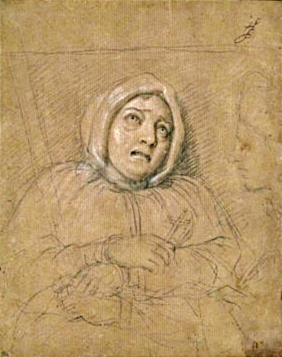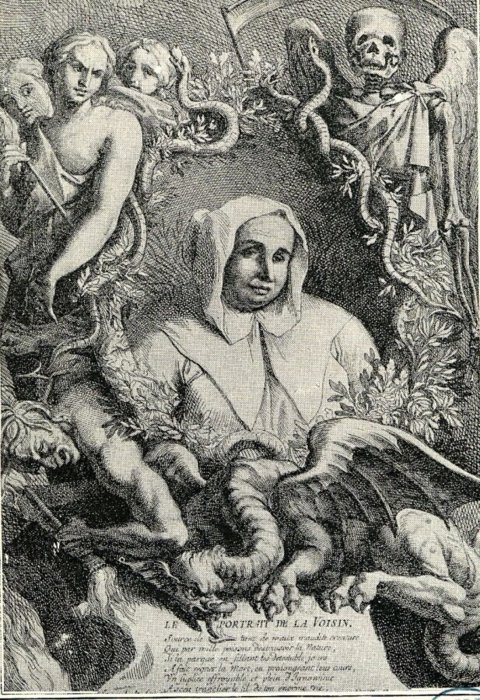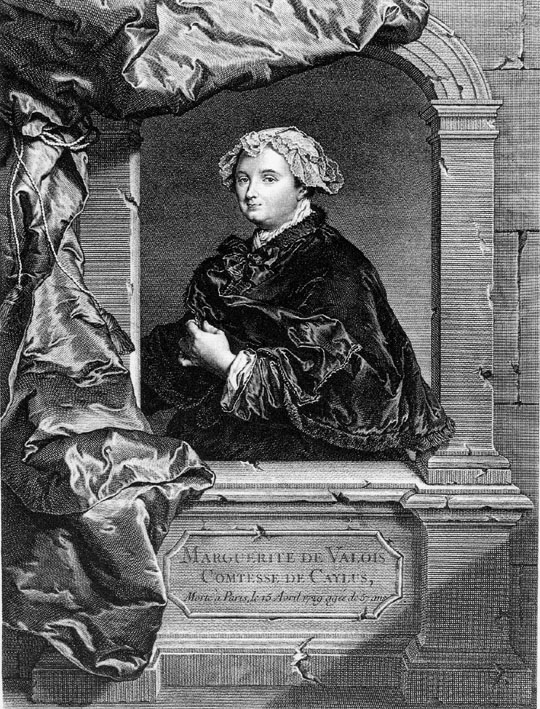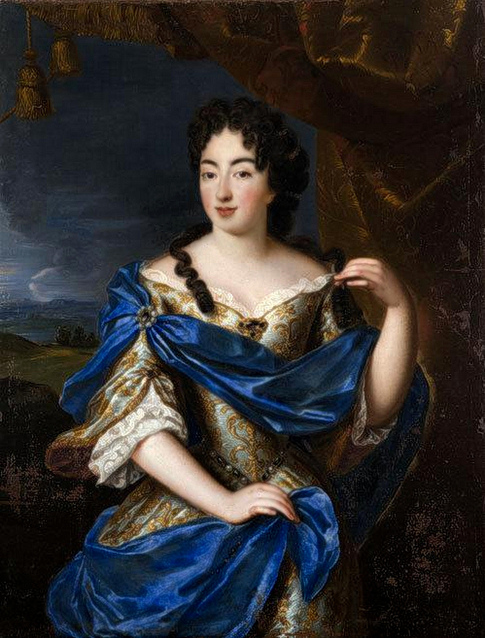Marie Bosse, palm-reader and poisoner
After the arrest of Madame de Brinvilliers, who had conspired with her lover to murder half her family in order to inherit wealth and property, the people of Paris and Louis XIV’s court were not just truly shocked by it all, the arrest also made them remember quite the number of strange and mysterious deaths and talk of powders and potions.

Then, a couple of years later, a certain Magdelaine de La Grange was arrested. She was a widow who worked as a fortune-teller to make a living after her husband had been executed for theft. Magdelaine de La Grange took advantage by the poison-paranoia and became quite wealthy by telling people they had been poisoned and offering the fitting antidotes for money. By the mid 1670s, de La Grange was living in extreme luxury at the expense of a rich lawyer called Jean Faurye. She and Monsieur Faurye, saying they were married, went to a clerk, in order to issue a will benefiting de La Grange… Monsieur Faurye died shortly after. His family found that a little suspicious and reported the matter. It turned out that the Monsieur Faurye who had visited the clerk with her, was actually not the real Monsieur Faurye, but a certain Abbé Nail, de La Grange’s lover, and this Abbé Nail had forged the marriage contract they handed the clerk. Both of them were arrested and accused of poisoning the real Monsieur Faurye.
A couple of months later, a man called Louis de Vanens was arrested. He claimed to be an alchemist being able to turn lesser metals into gold… when he was really just forging false coins… but apparently he also sold the so-called inheritance-powders. As a connection was discovered between Magdelaine de La Grange and Louis de Vanens, the police, and their chef Gabriel Nicolas de la Reynie, started to fear there might be an underground circle of poisoners operating in Paris. Magdelaine de La Grange even hinted as much and also named a woman called La Bosse as the one who provided her with inheritance-powders.
Gabriel Nicolas de la Reynie was ordered to investigate if there really was a secret ring of poisoners endangering the life of innocent people… and his worst nightmare became true. A letter was found that implied a person of very high rank, and whose name was stated as you-know-who, was about to be poisoned with the help of a white powder. Due to the strange nature of this letter, de la Reynie figured you-know-who was mostly likely Louis XIV. Thus finding the poisoners became a priority… but were to start?
As it happened, one of those poisoners was rather talkative when tipsy. It was Marie Bosse, the same person Magdelaine de La Grange mentioned, and her loose tongue kicked the infamous affaire des poisons into full swing. Madame Bosse was the widow of a horse-trader and in order to earn a living, she started to read palms. She did it so well, that more and more people sought her service… not just to learn their futures from her. Marie also started to mix and sell powders which ought to bring a swift demise. In winter 1679, Marie Bosse attended a part held by her friend Marie Vigoreaux, the palm-reading wife of a dressmaker. Another guest at this party was Monsieur Perrin, a lawyer of the Parlement. Marie Bosse and Monsieur Perrin did some chit-chatting and after a couple of glasses of wine, as the topic of conversation turned to Bosse’s wealth, she remarked joyfully that she will be able to retire soon. Saying that her business with inheritance-powders was going so well, that when she would poison another two or three people she would have enough money not to work again.

Monsieur Perrin could not believe what he just had heard, and how the other guests just laughed about it as if it was the most normal of things, and decided to tell the police. He turned to Monsieur Desgrez, who was involved in the arrest of Brinvilliers, and the wife of an officer was sent to Marie Bosse with a made-up story of being beaten by her husband. The wife returned with a white powder in her possession that was supposed to help her with her problem. It was arsenic.
On 4 January in 1679, the house in which Marie Bosse lived with her children was surrounded by the police and La Bosse dragged from her bed. She, her children and also Marie Vigoreaux were all arrested and brought to the Bastille. Bosse and Vigoreaux both insisted they were not the ones the police ought to worry about, for while they may have engaged in palm-reading they were only small fish in the dark water. The big fish were still out there, in the alleys of Paris and hidden behind nice facades, selling powders and poison. Bosse and Vigoreaux claimed to have never done something like that.
…what was found in Bosse’s house told a different story. The police searched the building, which had been sealed after her arrest, and found an assortment of strange powders and ingredients commonly used for various kinds of powders. Some of it was quite harmless and used for love potions, things like Spanish Fly, nail clippings and dried menstrual blood… but the police also found a fair amount of arsenic. The powders they found, were given to a dog, who repeatedly vomited afterwards. The dog did not die, but the vomiting was enough of a hint that those powders might be deadly if consumed in greater amounts.
As Marie Bosse was confronted with the findings, she claimed she battled boredom by trying chemistry to amuse herself. It was all really harmless, she said, adding that she could tell the police who was really guilty of murder by poison… and started to talk. Bosse named a lot of people, of which some were her rivals, and Gabriel Nicolas de la Reynie had them all arrested. Among those named was also a woman called La Voisin.
The prisons in and around Paris were quickly filled with women and men accused of selling poison as well as their families. And the more people were arrested, the more stories of murder by poison surfaced. Those arrested, trying to safe their necks, tried to put the blame on others and were in turn accused of even more vile crimes. La Bosse accused La Voisin of selling poisons, La Voisin argued what she did was harmless and La Bosse was the one to sell poisons. It went back and forth, more people were arrested and more names of customers stated… and the whole thing reached new dimensions. La Voisin suddenly said she knew plenty ladies at court who went to this or that fortune-teller to buy love potions and inheritance powders or even held black masses. Madame de Montespan was one of them.

Louis XIV was shocked as he heard of it and ordered the whole think to be covered up. The people of France could under no circumstance know that his mistress participated in black masses and gave him love potions, like La Voisin claimed. It would mean he was a mere puppet controlled by a power-greedy woman.
One of the people La Bosse accused of poisoning was a certain Marguerite de Jehan, a witty beauty from a Bordeaux noble family, who had been married the much older Alexandre de Poulaillon. Madame de Poulaillon was celebrated as one of the most beautiful women in Paris and her marriage was rather unhappy. She did not want to marry Alexandre de Poulaillon, but her family wanted it. After the marriage, she met a young and handsome gentleman who called himself the Marquis de Riviére. He was a dashing adventurer, who made merry with married women to live from their husbands fortunes. Madame de Poulaillon fell in love with him, but he was an expensive lover.
She sold what she had, her furniture, silver, jewellery and clothing, to keep him entertained… but it was never enough. Thus, with nothing left to pawn, Madame de Poulaillon turned her eyes to Monsieur de Poulaillon’s belongings. And that was when La Bosse entered the game. Madame de Poulaillon had pawned some of her belongings to La Bosse and desperate to get into possession of her husband’s money, she asked La Bosse how she could achieve that as quickly as possible. Bosse suggested Madame de Poulaillon should try to pry her husband’s strongbox open, but that did not work out for the suspicious husband had another lock installed on the strongbox. Madame de Poulaillon returned to La Bosse and requested to be provided with the means to rid herself of that silly husband. Bosse sold her some savon noir, a arsenic paste that was rubbed against the clothes and would cause nasty lesions and blisters similar to those caused by venereal diseases. The victim would fall ill and be weakened, which gave the poisoner the chance to act doting and nurse the victim, to be free of suspicion later on, while secretly adding more poison the victim’s food and drink. Madame de Poulaillon was not willed to do it this way, it was too slow for her, and instead managed to get a servant to add arsenic to Monsieur de Poulaillon’s wine. Luckily, Monsieur de Poulaillon did not drink that wine. Madame de Poulaillon was arrested and spent the rest of her life in various prisons and work-houses.
Apart from using arsenic substances to poison clothes, La Bosse was very fond of using opiates to induce ever-lasting-sleep, deadly herbs and so-called secret du crapaud. A small vial of the latter, she claimed, sold for as much as 200 Louis d’or. A real fortune. She created the secret du crapaud -toad poison- herself and according to her son, she taught him how to create it in order to poison goblets of silver.
Marie Bosse spilled the beans on all of that while being imprisoned and was sentenced to torture and death at the stake along with her friend Marie Vigoreaux. Three days after the death sentence, on 9 May in 1679, Marie Vigoreaux was taken to receive her share of torturing and did not survive it. She died of a head wound. Marie Vigoreaux’s body was removed from the torture chamber and La Bosse led in for her turn.
The next day, on May 10, Marie Bosse and one of her former clients were carted to their execution.
The route from the Bastille to Notre-Dame, were the cart stopped for the condemned to recite the prayers for forgiveness and pay a fine to the Church, was packed with people. One of the was La Bosse’s daughter, who had been ordered to watch the execution of her mother. The cart proceeded to the Place de Gréve, today’s Place de l’Hôtel-de-Ville, were a pile of hay and wood awaited La Bosse. Her screams echoed loudly.





One Comment
Tess
I needed a day like today (Halloween) to find out how many creepy articles you wrote. 17th century was a really spooky time… 😉